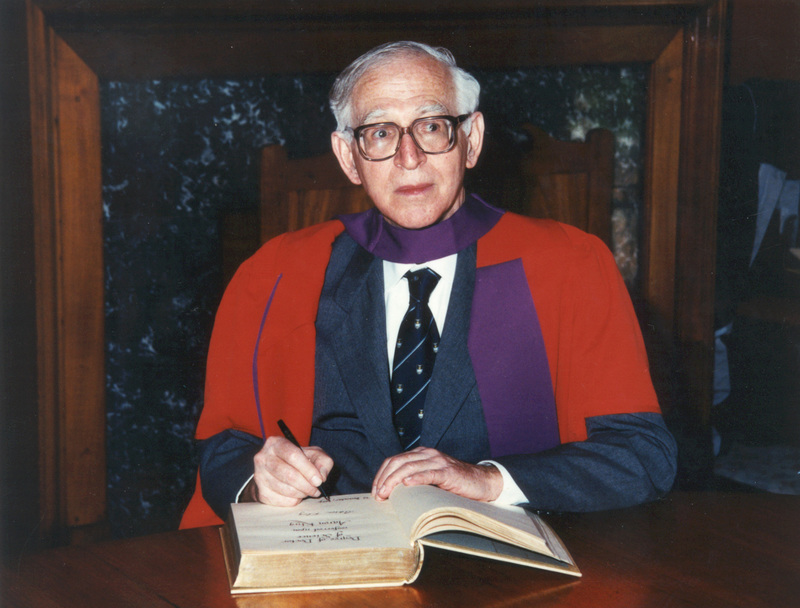Sir Aaron Klug: 1926–2018
20 November 2018
11 August 1926 – 20 November 2018
Sir Aaron Klug, who died on 20 November aged 92, and who was awarded the Nobel Prize in Chemistry in 1982 for his invention of three-dimensional electron microscopy and his work in charting the complex structures of chromosomes, had close ties to the University of Cape Town (UCT).
Klug was born to Jewish parents in Zelvas, Lithuania. His family migrated to Durban, South Africa, where his mother had relatives, when he was two years old. A voracious reader with wide-ranging interests, he matriculated from Durban High School with a class of boys two years older than himself. Aged just 15, he won a scholarship to the University of the Witwatersrand where he took a pre-medical course and, in his second year, studied biochemistry. Later he moved to chemistry, which in turn led him to physics and mathematics, and finally a science degree.
He followed this with a master’s in physics at UCT, where his supervisor was Reginald William James, the university’s first professor of physics and subsequently its vice-chancellor. James was an X-ray crystallographer who had worked alongside one of the subject’s founders, Lawrence Bragg, at the University of Manchester. After his master’s, Klug stayed on at UCT as a lecturer and worked on the X-ray analysis of some small organic compounds. It was during this time, he later wrote in his Nobel biography, that he developed “a strong interest ... in the structure of matter, and how it was organised”.
His accomplishment of the introduction of accurate densitometry into the field of X-ray crystallography so impressed James that in 1949 he recommended Klug to Bragg, who was then at the Cavendish Laboratory at Cambridge. Klug had hoped to join the new Medical Research Council unit at the Cavendish, which was exploring the nature of proteins. However, as things turned out, he obtained his PhD in solid state physics under Douglas Hartree, successfully modelling the austenite-pearlite phase transitions in steel and using EDSAC, one of the world’s first computers. He developed the nucleation and growth model that has been applied in many systems.
Following his PhD, Klug wished to do postdoctoral studies in the United States but was denied a visa when the South African government told the US authorities he was a communist. He returned to Cambridge where he spent a year working on the diffusion of oxygen into haemoglobin with FJW Roughton. In late 1953 he was awarded a Nuffield Fellowship that enabled him to work in the physics department of JD Bernal – the father of “structural molecular biology” – at Birkbeck College in London.
Klug’s arrival in the department led to his chance meeting with X-ray crystallographer Rosalind Franklin who introduced him to the study of viruses. In particular, he determined the helical symmetry of the tobacco mosaic virus and progressed towards the determination of the three-dimensional structure of spherical viruses by electron microscopy. Following 1959 his work on spherical viruses led to the realisation that the images of viruses being obtained with the electron microscope were projections that contained information about the whole three-dimensional structure.
His conceptualisation was mathematically rigorous and, in particular, made it possible to calculate how many views were necessary to reconstruct an object at a specific resolution. The inventors of X-ray computed tomography (CT) scan later developed them from his methods.
Klug’s subsequent scientific work was of a fundamental nature that has had an impact on a broad range of health issues: the structure of chromatin, the structure of transfer RNA, and the structure of telomeres are but a few of the areas in which he made seminal contributions.
He was also the discoverer of zinc-finger proteins, a class of proteins that bind specific DNA sequences by means of arrays of “fingers”, each of which interacts with a run of three or four base pairs. The modular nature of these proteins has made it possible to design synthetic proteins with a wide range of specificities, opening the prospect of targeted therapies for a wide range of diseases. It is perhaps this work for which he will ultimately be remembered.
Between 1986 and 1996 Klug was director of the Laboratory of Molecular Biology at Cambridge, and was knighted by Queen Elizabeth II in 1988. He was elected president of the Royal Society and served from 1995 to 2000. He was awarded the Order of Mapungubwe (Gold) in 2005 by former South African President Thabo Mbeki.
Klug was one of the founding trustees of the UCT Trust and chairperson from 1993 to 2010. During his time in office at the UCT Trust, more than £17 million was raised for projects at UCT. He was a frequent visitor to Cape Town where he lectured at the university and gave generously of his time, discussing projects with staff and students in the Department of Biochemistry. He received four awards from UCT: the President of Convocation Medal, the Chancellor’s Gold Medal of Merit (1982), an honorary doctorate (1997) and the Vice-Chancellor’s Medal (2010).
Professor Bryan Sewell of UCT’s Department of Integrative Biomedical Sciences, wrote of him: “Sir Aaron Klug symbolises what every scientist strives for – brilliant insight, the combination and reconciliation of theory and experiment, and the wide-ranging application of ideas to many fields.”
Klug is survived by his wife Liebe and son David. Another son, Adam, died in 2000.
 This work is licensed under a Creative Commons Attribution-NoDerivatives 4.0 International License.
This work is licensed under a Creative Commons Attribution-NoDerivatives 4.0 International License.
Please view the republishing articles page for more information.









